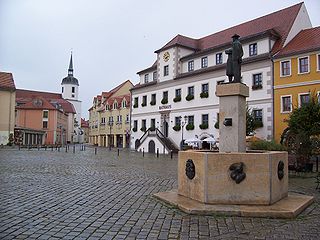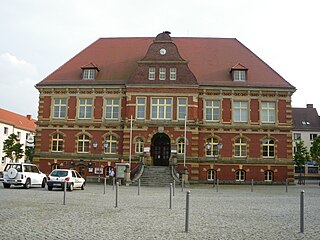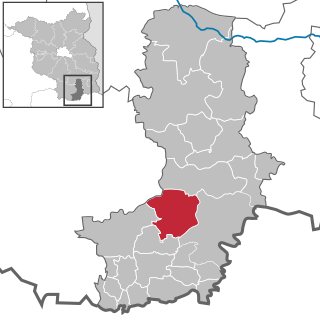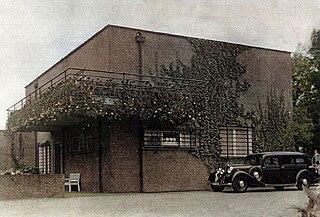
Lusatia is a historical region in Central Europe, territorially split between Germany and modern-day Poland. Lusatia stretches from the Bóbr and Kwisa rivers in the east to the Pulsnitz and Black Elster rivers in the west, and is located within the German states of Saxony and Brandenburg as well as in the Polish voivodeships of Lower Silesia and Lubusz. Major rivers of Lusatia are the Spree and the Lusatian Neisse, which defines the border between Germany and Poland. The Lusatian Mountains of the Western Sudetes separate Lusatia from Bohemia in the south. Lusatia is traditionally divided into Upper Lusatia, the hilly southern part, and Lower Lusatia, the flat northern part.
The district of Bautzen is a district in the state of Saxony in Germany. Its largest towns are Bautzen, Bischofswerda, Kamenz, Hoyerswerda and Radeberg. It is the biggest district in Saxony by area, and a member of the Neisse Euroregion.

Hoyerswerda or Wojerecy is a major district town in the district of Bautzen in the German state of Saxony. It is located in the Sorbian settlement area of Upper Lusatia, in which the Upper Sorbian language is spoken in addition to German.

Domowina is a political independent league of the Sorbian and Wendish people and umbrella organization of Sorbian societies in Lower and Upper Lusatia, Germany. It represents the interests of Sorbian people and is the continual successor of the previous Domowina League of the Lusatian Sorbs. The organization has been a member of the Federal Union of European Nationalities since 1990.

Upper Lusatia is a historical region in Germany and Poland. Along with Lower Lusatia to the north, it makes up the region of Lusatia, named after the Slavic Lusici tribe. Both parts of Lusatia are home to the West Slavic minority group of the Sorbs.

The Eurasian wolf, also known as the common wolf, is a subspecies of grey wolf native to Europe and Asia. It was once widespread throughout Eurasia prior to the Middle Ages. Aside from an extensive paleontological record, Indo-European languages typically have several words for "wolf", thus attesting to the animal's abundance and cultural significance. It was held in high regard in Baltic, Celtic, Slavic, Turkic, ancient Greek, Roman, Dacian, and Thracian cultures, whilst having an ambivalent reputation in early Germanic cultures.

Senftenberg (German) or Zły Komorow is a town in Lower Lusatia, Brandenburg, in eastern Germany, capital of the Oberspreewald-Lausitz district.

Bernsdorf or Njedźichow is a town in the district of Bautzen, in Upper Lusatia, Saxony, Germany. The town has 6,427 residents. It is 12 kilometres (7.5 mi) north of Kamenz and 15 kilometres (9.3 mi) southwest of Hoyerswerda. The town Bernsdorf consists of Bernsdorf proper and the Ortschaften Großgrabe, Straßgräbchen, Wiednitz and Zeißholz.

Calau is a small town in the Oberspreewald-Lausitz district, in southern Brandenburg, in eastern Germany. It is situated 14 km south of Lübbenau, and 27 km west of Cottbus. Calau is also called the home of the Kalauer.

is a town in the Oberspreewald-Lausitz district, in Upper Lusatia, Brandenburg, in eastern Germany. It is situated on the river Schwarze Elster, 12 kilometres (7.5 mi) southwest of Senftenberg.

Schipkau is a municipality in the Oberspreewald-Lausitz district, in Lower Lusatia, Brandenburg, Germany.

The term West Lusatia was coined in the 1950s for the old counties of Hoyerswerda, Kamenz and Bischofswerda – mainly in order to make the Museum of West Lusatia into a centrepoint. Culturally and historically, West Lusatia corresponds to western Upper Lusatia, including part of the Brandenburg county of Oberspreewald-Lausitz, between the rivers Pulsnitz and Black Elster.

The Upper Lusatian Railway Company, which had its headquarters in Ruhland now in the Oberspreewald-Lausitz district, received a concession on 11 October 1871 for the construction of a railway line, partly to provide a direct connection from Breslau to Magdeburg. The 148 km long-route lead west from the rail node of Kohlfurt through Upper Lusatia via Horka, Hoyerswerda, Ruhland and Elsterwerda-Biehla to Falkenberg in the Lower Lusatia.

Wolf distribution is the species distribution of the wolf. Originally, wolves occurred in Eurasia above the 12th parallel north and in North America above the 15th parallel north. However, deliberate human persecution has reduced the species' range to about one-third, because of livestock predation and fear of wolf attacks on humans. The species is now extirpated in much of Western Europe, Mexico, and the contiguous United States, and completely from the British Isles and the Japanese archipelago. In modern history, the gray wolf occurs mostly in wilderness and remote areas, particularly in Canada, Alaska, the Northern United States, Europe and Asia from about the 75th parallel north to the 12th parallel north. Wolf population declines have been arrested since the 1970s, and have fostered recolonization and reintroduction in parts of its former range, due to legal protection, changes in land-use and rural human population shifts to cities. Competition with humans for livestock and game species, concerns over the danger posed by wolves to people, and habitat fragmentation pose a continued threat to the species. Despite these threats, because of the gray wolf's relatively widespread range and stable population, it is classified as Least Concern on the IUCN Red List. In Africa the population of wolves is limited to the northern regions with the African golden wolf north of the Sahara and the Ethiopian wolf in Ethiopia.

Villa Wolf was an architecturally significant building in Gubin, Poland, designed by the German architect Ludwig Mies van der Rohe. It is also known as Haus Wolf. The property was developed in Guben, Germany, between 1925 and 1926 – two decades before the Oder–Neisse line divided the city to create Gubin – for Erich and Elisabeth Wolf. It was one of the pioneering prototypes of modern architecture in Europe, and is considered the first modern work of Mies van der Rohe. It stood between two gardens parallel to the Lusatian Neisse river at Teichbornstraße 13 in today's Gubin, which at that time still belonged to Guben, but is now located in the Polish part of Lower Lusatia. It was destroyed during World War II in 1945 and there are plans to reconstruct it.
LUPUS - Institute for Wolf Monitoring and Research in Germany is a research institute with its headquarters in Spreewitz. It was founded in January 2003 as Wildbiologisches Büro LUPUS by the biologists Gesa Kluth and Ilka Reinhardt and is managed by them until today (2019). Their main area of work is the scientific monitoring and research of the natural repopulation of Germany by the wolf. LUPUS works on behalf of the Saxon State Ministry for the Environment and Agriculture and is supported among others by the Bundesamt für Naturschutz, the Bundesforst, the Bundesanstalt für Immobilienaufgaben and the International Fund for Animal Welfare.
Gesa Kluth is a German biologist and wolf expert.
Hoyerswerdaer FC is an association football club from Hoyerswerda, Saxony, Germany.

The Sorbian settlement area commonly makes reference to the area in the east of Saxony and the South of Brandenburg in which the West Slavic people of the Sorbs live autochthonously. In colloquial German, it is called Sorbenland ; before 1945 also – sometimes pejoratively – called Wendei.















